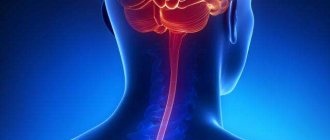Cryptococcal meningitis most often develops in patients with a weakened immune system with a history of malignant neoplasms, AIDS, diabetes mellitus, uremia, hemoblastosis and other diseases. The Yusupov Hospital provides diagnostic services for the disease, consultations are carried out by highly qualified doctors. The hospital includes several clinics, including a rehabilitation department, an inpatient unit, and a diagnostic center. The diagnostic center of the Yusupov Hospital offers innovative equipment, modern technologies, and highly effective diagnostic care.
Cryptogenic meningitis: cause
Meningitis of this type can develop in a patient after long-term treatment with large doses of corticosteroids, antibiotics, cytostatics and immunosuppressants, after organ transplantation. Cryptogenic meningitis is a fungal infection of the meninges, most often caused by cryptococcus. Cryptococcosis affects people with a weakened immune system; infection with fungi occurs through inhalation; the pathogen can remain latent in the lungs for a long time. It is the lungs that are the primary site of localization of the pathogen.
A fungal infection is activated when the function of the immune system decreases and affects the patient’s organs and tissues. Cryptococcosis may be asymptomatic or may manifest itself with various symptoms. The most common form of the disease is cerebral cryptococcosis - the pathogen affects the central nervous system through the hematogenous route. When fungi enter the brain vessels, the walls of blood vessels are destroyed, blood microcirculation is disrupted, focal brain lesions and neuronal degeneration develop.
The permeability of brain vessels increases, which leads to the accumulation of fluid in the brain substance. Autopsy shows serous-productive meningitis with multiple small hemorrhages in the hard and soft membranes of the brain. There is an accumulation of fungi on the surface of the meninges. The pathological process often involves the basal surface, leading to the development of cerebral edema and death.
Meningococcal infections
Meningococcal infection is an infectious disease caused by the bacterium Neisseria meningitidis
. There are 12 serogroups (varieties) of this bacterium, of which 6 (A, B, C, W, Y and X) cause most severe forms of meningococcal infection. The peculiarity of the infection is that meningococcus, like Haemophilus influenzae type b and pneumococci, has a polysaccharide capsule that surrounds the bacterium and protects it from attacks by the immune system. Young children (aged 0 to 5 years) usually do not yet have developed protective immunity against this infection. (1)
Reasons and sources. Incubation period
The causative agent of meningococcal infection is transmitted only from person to person. The infection spreads by airborne droplets and enters the body through the mucous membranes of the nose, mouth and pharynx. The smallest drops of secretions from the respiratory tract, oral cavity or nasopharynx of a carrier or a sick person during close contact - kissing, sneezing, coughing - fall on the mucous membrane of a healthy person. There, bacteria can remain and multiply for some time without causing signs of disease or affecting well-being, causing asymptomatic carriage (sometimes symptoms of a runny nose [nasopharyngitis] are observed). According to available data, it is believed that at any given time, about 10-20% of the population are carriers of meningococci. But sometimes, for reasons that are not entirely clear, suppressing the body’s defenses, the infection penetrates through the mucous membrane into the blood. Using nutrients in the blood, meningococci can multiply rapidly, causing blood poisoning (sepsis), and spread through the blood into the membranes of the brain or other internal organs (for example, lungs, joints, heart, subcutaneous fat, etc.). (12)
The time between the moment a bacterium enters the body and the first signs of illness appears is called the incubation period . For meningococcal infection, it averages 4 days, but can vary from 2 to 10 days. (2)
Forms of the disease
The forms of the disease mean what the nature of the disease is, how it progresses, what organs and systems it affects. In cases of meningococcal infection, the following forms exist:
- Localized forms. They develop when the body’s defenses cope with the infection and it does not enter the blood.
- Asymptomatic carriage: bacteria Neisseria meningitidis
remains on the mucous membrane, multiplies and is periodically released into the external environment. The person himself is not sick, but is contagious to others.
- Acute nasopharyngitis: inflammation is limited to the nasal mucosa and nasopharynx.
- Generalized forms - meningitis , meningoencephalitis, sepsis (blood poisoning). They develop if the pathogen overcomes the local immune defense on the mucous membranes of the nasopharynx and enters the blood. With the bloodstream, bacteria spread throughout the body, penetrating the skin, kidneys, adrenal glands, lungs, heart tissue, and membranes of the brain. The reproduction and death of meningococci leads to the release of endotoxin, a toxic product of bacterial breakdown. It destroys the walls of blood vessels, causing hemorrhages to form, which at first look like a rash ( exanthema ) - reddish dots on the skin or enanthema - as well as rashes on the mucous membranes of the mouth, nasopharynx, and sometimes the eyes, and then take on the typical appearance of hemorrhagic (from dark red to black) rash ranging in size from dots to extensive necrosis (death) of skin areas. The same bacterial toxin leads to the development of cerebral edema and brain symptoms, hemorrhages in the internal organs.
- Mixed (a combination, for example, of meningitis and sepsis) and rare forms: the development of inflammation in the joints - polyarthritis, in the lungs - pneumonia, etc. (1) (2) (3)
Symptoms of meningococcal infection
Carriage. It proceeds without complaints, lasts on average 10-15 days, the pathogen is detected only during laboratory examination.
Acute nasopharyngitis. Symptoms of meningococcal acute nasopharyngitis may resemble ARVI - fever, weakness, headache, drowsiness, mucus and slight nasal congestion. It may result in recovery, transition to carrier status, or cause the development of meningitis and other severe forms of meningococcal infection. In any case, even with minimal suspicion or risk of infection with meningococcus, you need to call a doctor, since it is impossible to independently determine whether it is really meningococcal nasopharyngitis or another infection: an examination and laboratory tests are necessary.
Meningococcemia (sepsis, blood poisoning). It develops quickly, often against the background of nasopharyngitis. The temperature may rise sharply, with muscle aches, severe headaches, and clouding of consciousness. Within 1-2 days, a typical rash appears during meningococcal infection - first pinkish, then hemorrhagic: uneven rashes, dark red in color, slightly raised above the skin. As a rule, the rash is localized on the buttocks, legs, and lower torso. The elements of the rash are very different, from “pinprick” and red-brown “stars” to large hemorrhages, which in severe cases lead to tissue death - necrosis. An unfavorable sign is the early appearance of a rash on the face. (1)
Meningitis . According to the source (1) in Russia, “50% of all bacterial meningitis in children under 5 years of age” is caused by meningococcus. Meningococcal bacterial meningitis begins acutely, the temperature can quickly increase to high numbers, and at the same time complaints of pain in the back, neck, severe headache with intolerance to light and sounds may appear. Vomiting is repeated many times, it does not bring relief. Consciousness is confused, the person shrinks into a ball: he lies on his side, with his legs pulled up to his stomach, a typical description of this sign is “the posture of a pointing dog.” The general condition is usually severe or very severe.
Symptoms can quickly develop - sometimes on the first day, but more often 2-3 days after the onset of signs of the disease - indicating that the infectious-inflammatory process has affected the membranes of the brain and caused their irritation. Such symptoms are called meningeal, they include: stiff neck (impossible to press the chin to the chest), Kernig’s symptoms (the doctor cannot straighten the patient’s leg at the knee), Brudzinsky’s (simultaneous bending of the head and pulling the legs towards the stomach) and others. A typical rash may appear. (13)
Meningeal symptoms can indicate the severity of the disease, but you should not determine it on your own, without a doctor: a comprehensive check and experience in assessing symptoms is needed.
Meningoencephalitis. Inflammation affects the meninges, brain, and sometimes the spinal cord. Signs are similar to those of meningitis, and a rash also develops. exanthema and enanthema may appear . An exanthema is a variety of skin rashes that can occur with a variety of infections and allergies; this is a general description of rashes. Enanthema is a rash of a different nature that appears on the mucous membranes. At the very beginning of meningoencephalitis, it may be difficult to determine the type of rash. It may begin as roseola, a small, 1 to 10 mm in diameter, rounded red lesion that lightens or disappears when pressed. Then it can turn into a hemorrhagic rash in the form of dots, spots, stars of different sizes, which do not disappear when you press on them. (13)
Meningococcal sepsis (menigococcemia) is a severe form of the disease. The condition of the patients is very serious: severe headache, vomiting, the temperature can be either very high - 41 ° C, or below 36.6 ° C. This is due to a very rapid disruption of the functioning of blood vessels, a drop in blood pressure. A maculopapular rash : spreading over the skin and mucous membranes, it often merges to form blisters with bloody contents. The mortality rate for this form is very high - up to 60%. (13)
Diagnosis of meningococcal infection
An accurate diagnosis can only be made after a laboratory test: if the doctor suspects meningococcal infection, he will prescribe a test of blood, cerebrospinal fluid, mucous discharge and rash.
According to the source (1), even with a timely and correct diagnosis and correctly prescribed treatment, “the risk of death is high. In the 10-20% of people who survive, bacterial meningitis can cause brain damage, hearing loss or learning difficulties. In severe cases, gangrene of the fingers, toes, and ears is possible.” Therefore, if at least one of the symptoms that resembles the description of the symptoms of meningococcal infection, sepsis and any other forms develops, it is recommended to call an ambulance.
A preliminary diagnosis, and then its clarification, is possible only after a clinical examination, with the obligatory collection of cerebrospinal fluid - cerebrospinal fluid, as well as smears from the surface of the nasopharyngeal mucosa and rash using a spinal puncture. According to source (1), “Meningococcal disease is potentially fatal and should always be treated as a medical emergency. The patient must be admitted to the hospital.”
Treatment
Treatment depends on the form of the disease. Hospitalization is required for any form, but if, when asymptomatic carriage of meningococcal infection and nasopharyngitis is detected, antibiotics and vitamin and mineral preparations can be prescribed, then other forms of the disease require emergency intervention and intensive treatment . (13)
Depending on the form of the disease, the characteristics of the course, the age of the patient and other reasons, antibiotics may be prescribed; their combination and dose adjustment may be required. You may also need medications to reduce fever, relieve seizures, improve blood circulation and for detoxification, maintain the functioning of the cardiovascular system, brain, and reduce the risk of possible complications. Other measures to maintain vital functions, including ventilation, may be required. For treatment to be as effective as possible, “it is important to identify the serogroup of meningococcus and test the microorganism for sensitivity to antibiotics.”(3)
At-risk groups
The infection caused by meningococcus is equally dangerous for all people except those who have received the meningococcal vaccine. According to WHO (2), 10–20% of the population are considered asymptomatic carriers of the meningococcal bacterium N. meningitidis
. The following groups are at increased risk for the development of meningococcal infection (1) (2) (3):
- Children of primary and preschool age. In the absence of vaccination, protective immunity against meningococci in children under 5 years of age, as a rule, has not yet been formed. It is also important that children often put toys and environmental objects in their mouths, share food with each other, and drink from common dishes. This increases the risk of transmission of infection if there is a child or adult asymptomatic carrier of meningococci without signs of disease .
- Teenagers and young adults with a large number of social contacts, living and communicating in crowded conditions (parties, discos, dormitories, barracks). As stated above, about 10-20% of people are considered possible asymptomatic carriers of meningococcal disease. The more and more intense the contacts, the higher the risk of becoming infected.
- For the same reason, conscripts and recruits are at risk.
- Persons who have had their spleen removed, with HIV infection, or with certain genetic disorders. These are people with immunodeficiency—reduced ability of the body to resist infections.
- Persons with cochlear implants. If you have hearing impairment and wear a cochlear implant, there may be damage to the internal structures of the ear and a decrease in local immunity, which may pose a certain risk of infection.
- Travelers to areas where the incidence of disease is high, the countries of the so-called “meningitis belt” in Africa, as well as to Saudi Arabia for the Hajj. A long dry period, wind, dust from dry soil, cold nights, and the prevalence of upper respiratory tract infections reduce the protective capabilities of the nasopharyngeal mucosa. Low indicators of socio-economic development (except in the UAE and Saudi Arabia), overcrowding, displacement of large numbers of people due to traditional nomadic lifestyles, and in Saudi Arabia due to pilgrimage, increase the risk that large numbers will gather in relatively small areas people, among whom there may be asymptomatic carriers of meningococcal infection and patients, which can lead to outbreaks of infection.
Prevention
The short incubation period , the difficulty of early diagnosis, the rapid development of symptoms, the prevalence of carriage, the characteristics of children's immunity, the high level of mortality and disability, as well as the high prevalence of infection in some countries of the world require preventive measures in children and individual adults at risk.
In case of outbreaks of meningococcal infection (limited or in epidemics), so-called outbreak measures can be carried out by medical workers. These include the establishment of quarantine, identification and isolation of carriers, compliance with the sanitary and epidemiological regime, and other measures. (3)
The most effective measure is active immunization, that is, preventive vaccination. In Russia, it is included in the Calendar of Preventive Vaccinations for Epidemic Indications (4). It states that vaccination is required for “children and adults in areas of meningococcal infection caused by meningococcal serogroups A or C. Vaccination is carried out in endemic regions, as well as in the event of an epidemic caused by meningococcal serogroups A or C.” Persons subject to conscription for military service are also subject to vaccination. (4)
The list of vaccines that can be used in Russia for vaccination against meningococcal infection includes:
- Meningococcal polysaccharide vaccines:
- monovalent (against serogroup A) - dry polysaccharide;
- tetravalent (against serogroups A, C, Y and W).
- Meningococcal conjugate vaccines:
- monovalent (against serogroup C).
- tetravalent (against serogroups A, C, Y and W). (5) (6)
According to the World Health Organization, “conjugate vaccines are preferable to polysaccharide vaccines because they can provide herd immunity and also have higher immunogenicity, especially in children under 2 years of age.” (7)
Show sources
Sources
- Meningococcal infection. [Electronic resource]. URL: https://www.yaprivit.ru/diseases/meningokokkovaya-infekciya (as of 07/04/2017)
- World Health Organization. Meningococcal meningitis. Newsletter No. 141, November 2015 URL: https://www.who.int/mediacentre/factsheets/fs141/ru (accessed 07/04/2017)
- Berezhnova I.A. Infectious diseases. — Textbook / I.A. Berezhnova - M.: RIOR. - 2007. - 319 p.
- Order of the Ministry of Health of the Russian Federation dated March 21, 2014 No. 125n “On approval of the national calendar of preventive vaccinations and the calendar of preventive vaccinations for epidemic indications” (with amendments and additions). URL: https://normativ.kontur.ru/document?moduleId=1&documentId=282161 (as of 07/04/2017)
- Abramtseva M.V., Tarasov A.P., Nemirovskaya T.I. Meningococcal infection. Conjugate polysaccharide meningococcal vaccines and new generation vaccines / Biological products. Prevention, diagnosis, treatment. - 2021 - volume 16, no. 1 (57) - p. 42.
- State register of medicines of the Russian Federation. URL: https://grls.rosminzdrav.ru (as of 07/04/2017)
- World Health Organization. Meningococcal vaccines: WHO position paper, November 2011. Wkly Epidemiol Rec 2011; 86:521-539. URL: https://www.who.int/wer/2011/wer8647.pdf (accessed 07/04/2017)
SPRU.MENAC.18.03.0032
Cryptococcal meningitis: symptoms and diagnosis
The most common complaints of patients are severe headache, high temperature, which can rise to 400C, nausea, and in most cases there are no meningeal symptoms. Very rarely, the patient has convulsions and impaired consciousness. Severe symptoms are characteristic of more severe and later stages of development of cryptococcal meningitis. With cryptococcal meningitis, a progressive decrease in glucose levels and an increase in protein levels are noted in the cerebrospinal fluid; analysis of the cerebrospinal fluid shows mild inflammatory changes.
Investigations for suspected cryptococcal meningitis are carried out using CSF analysis. Stained cryptococcal cells have an ellipsoidal or round shape and are well stained using the Mowry method - this allows visualization of the pathogen. Further studies to confirm the diagnosis make it possible to obtain additional data on the severity of damage to the brain substance, the state of the cerebral cortex, the presence of hydrocephalus, and other central nervous system disorders.
Meningitis
Meningitis is a disease that causes inflammation of the meninges: the protective membranes that cover the brain and spinal cord. Meningitis is most often caused by bacteria, viruses, protozoa and fungi. However, a non-infectious form of meningitis is possible, when the meninges become inflamed due to certain diseases, medications, or injuries. (1)
Causes of meningitis
The causes of the disease are various types of pathogens. Depending on their type, there are types of meningitis that they can cause:
- bacterial. It can be caused by various types of bacteria, including meningococci, staphylococci, streptococci, E. coli and others.
- viral. Possible pathogens of this form are mumps, herpes, influenza viruses, etc.;
- fungal can be caused by candida, cryptococcus;
- a form of meningitis caused by protozoa - its causes can be amoebas, toxoplasma and other protozoa;
- a mixed form of meningitis occurs if several pathogens are simultaneously detected in the body, each of which can cause meningitis.
Types, forms of meningitis
Depending on the speed of development of the disease, several forms are distinguished. Very rapid, sudden development of symptoms is a fulminant form of meningitis. The acute form of meningitis develops within 1–2 days. In subacute meningitis, symptoms develop over several days or weeks. Chronic meningitis lasts more than 4 weeks, and if after the symptoms disappear, the disease returns again, then it is recurrent meningitis.
Based on the type of inflammatory process, there are two types of meningitis - serous, which most often develops with a viral infection (enteroviruses, adenoviruses, mumps virus, influenza, tick-borne encephalitis) and purulent meningitis - a more severe form caused by a bacterial infection. The most common causative agents of purulent bacterial meningitis are meningococci, pneumococci, and Haemophilus influenzae type b (Hib).
Based on their origin, forms of meningitis are divided into primary and secondary. Primary develops as an independent disease. Secondary meningitis is a consequence or complication of an infection already existing in the body, for example, otitis media, influenza, tuberculosis, and often occurs in the form of serous meningitis.
According to the prevalence of inflammation, they are distinguished: spinal (or spinal cord meningitis) - the inflammatory process develops in the membranes of the spinal cord. If the inflammation is mainly localized in the upper part of the brain, then it is convexital meningitis, and with inflammation of the lower part of the brain, basal meningitis develops. The process, which involves both the brain and the spinal cord, is called cerebrospinal - this is how meningococcal meningitis often occurs. (1)
Symptoms of meningitis of the brain
Depending on the cause of meningitis, the symptoms of this disease may vary. But meningitis also has common symptoms called meningeal. They are divided into general cerebral symptoms - arising due to increased intracranial pressure and true meningeal symptoms, which arise due to inflammation of the lining of the brain. (1)
Among the early cerebral symptoms, headache most often appears. It can be widespread, or it can be observed in certain areas of the head; the severity of pain also varies. For many, the pain intensifies with noise, changing position, or turning on the lights. Young children may react to it with the so-called “brain scream” - these are repeated, monotonous, high-pitched screams.
The headache may be accompanied by severe sudden vomiting, which does not bring relief. There may be seizures, tics (uncontrolled movements of small muscles), and changes in consciousness.
Meningeal symptoms may include:
- typical pose with head thrown back, arms bent and legs pulled up to the stomach (“cooper dog pose”);
- rigidity (stiffness) of the neck muscles: an attempt to press the patient’s chin to the chest from the side fails;
- other symptoms indicating irritation of the meninges.
Other symptoms may vary depending on the type of pathogen that led to the disease and the type of meningitis. They are discussed separately in the description of the corresponding forms.
Viral meningitis
Viral meningitis can be caused by enteroviruses, including Coxsackie A, ECHO, mumps, parainfluenza viruses, viruses of the herpes family (causing herpes simplex, herpes zoster, Epstein-Barr disease, roseola infantile), tick-borne encephalitis virus and others.
According to the type of inflammation, this is most often serous meningitis.
The incubation period - the time from the moment the pathogen enters the body until the development of symptoms of the disease - in adults averages from 6 to 14 days. In children, it may be shorter or longer, and the signs of the disease may be less pronounced.
Viral meningitis clinic
As a rule, the first complaints to appear are those that may indicate an infectious disease: weakness, malaise, fever, headache. Then, within 1–3 days, meningeal symptoms appear, which may include neck stiffness, Brudzinski's symptoms, Kernig's sign, hypersensitivity to light, sounds, and touch. In infants, the fontanel may bulge and pulsate, and Lesage's symptom may be observed, in which the child, taken from the armpits, pulls his legs toward his stomach.
With some types of viral serous meningitis, the clinical picture may be unexpressed, erased, complaints may be moderate, and meningeal symptoms may appear erased and not obvious. Thus, meningitis that occurs against the background of adenovirus infection often occurs without meningeal symptoms, but with severe inflammation of the nasopharynx and upper respiratory tract, conjunctivitis.
Meningitis caused by the mumps virus can occur with intense abdominal pain, signs of pancreatitis, and inflammation of the testicles or ovaries.
A prolonged course can occur with meningitis caused by herpes viruses. It often begins with signs of herpes - typical blisters on the mucous membranes, herpes zoster, etc. Often, such meningitis occurs without meningeal symptoms.
Meningitis with tick-borne encephalitis is usually characterized by a rapid onset, with a rise in temperature, severe intoxication, muscle pain and meningeal symptoms. It can occur in waves - after an acute period, the temperature drops, and after a few days it rises again. Recovery is often delayed; weakness, asthenia, and neurological symptoms persist for quite a long time.
Diagnosis of viral meningitis
Only a doctor can make a correct diagnosis, so if you suspect that a patient may have meningitis, you should seek medical help. The doctor will interview the patient or his relatives, examine and assess the condition, and if necessary, in order to make sure that the symptoms are caused by inflammation of the meningeal membranes, he will prescribe a sample of cerebrospinal fluid and an assessment of its indicators.
Treatment
In most cases, treatment of viral meningitis is symptomatic. Recommends bed rest, dim lighting. At the onset of the disease, detoxification therapy is carried out according to indications, drugs are prescribed to alleviate symptoms: headache, vomiting, fever, abdominal pain, spasms, convulsions. For meningitis caused by a virus from the herpesvirus family, the doctor may prescribe an intravenous drip of the antiviral drug acyclovir.
With proper treatment, viral meningitis is usually quite mild, and the prognosis in most cases is favorable. (12)
Prevention
Vaccination in accordance with the National Vaccination Calendar of the Russian Federation can serve as the optimal way to protect against the risk of developing certain forms of viral meningitis. This is a vaccination against polio, mumps and measles viruses.
For other viruses, measures aimed at reducing the risk of transmission of the virus from carriers and patients to healthy people may be effective. These include:
- identification of sick people and timely separation of contacts (quarantine);
- compliance with personal hygiene and sanitary standards;
- strengthening and maintaining immunity;
- a set of measures from health authorities. (12)
Bacterial meningitis
Bacterial meningitis can be caused by meningococci, pneumococci, Haemophilus influenzae, tubercle bacilli, as well as staphylococci, salmonella, listeria and other bacteria. The inflammatory process in the membranes of the spinal cord and brain, caused by bacteria, in most cases is purulent.
“In 2015 in the Russian Federation, out of 2452 cases of purulent bacterial meningitis […] the etiological structure was dominated by meningococcus (44%). Next in frequency of isolation was pneumococcus (26%), followed by Haemophilus influenzae (10%). The share of other microorganisms accounted for 19%.” (3)
According to source (3) “the greatest risk of developing purulent bacterial meningitis of any etiology is typical for children under 5 years of age, while the risk of developing generalized forms of meningococcal infection is more pronounced in this group, followed by hemophilic meningitis in this age group, followed by pneumococcal meningitis”
Meningococcal meningitis
An acute onset of the disease is typical for this form. Intoxication and fever can be severe, as well as other symptoms. The intensity of complaints increases very quickly, there is a severe headache, fever, repeated vomiting that does not bring relief, a sharp increase in sensitivity to light, sounds, touches, and movement. Meningeal symptoms soon follow: “pointing dog pose,” Kernig’s and Brudzinski’s symptoms. In severe cases, the patient may experience convulsions, disturbances of consciousness, even coma.
In infants, the onset of purulent meningitis is accompanied by crying against a background of restless behavior, refusal to breastfeed, screams, a sharp reaction to touch (withdrawal of limbs, shuddering, increased crying), and convulsions. During the examination, meningeal symptoms may be detected - Lesage, stiff neck, typical meningeal posture.
As infection and inflammation spread and meningococci enter the blood, the patient's condition worsens. Meningococcemia (sepsis, blood poisoning) and infectious-toxic shock may develop. The symptoms described above will be accompanied by a hemorrhagic rash, and the functioning of the heart and blood vessels will deteriorate. With infectious-toxic shock, the deterioration of the condition can progress very quickly, fever and rash appear almost simultaneously, convulsions develop, and consciousness is impaired.
If you suspect meningococcal meningitis, it is recommended to seek urgent medical attention, as this form of meningitis can progress rapidly (even to death) and cause serious complications.
To make a diagnosis, the doctor relies on examination data and other examinations, based on the results of which he can prescribe cerebrospinal fluid tests, blood tests, and molecular diagnostic methods (for example, PCR) to clarify the type of pathogen. Based on the examination data, a diagnosis is established and treatment is prescribed: antibiotics, detoxification and symptomatic therapy; if necessary, correction of dehydration and other metabolic disorders can be carried out.
The duration of the disease with proper treatment can average from 2 to 6 weeks. Without treatment, there is a high probability of death or the development of severe complications leading to disability: according to the source, 10–20% of those who have had bacterial meningitis develop brain damage, hearing loss, cognitive impairment, and learning difficulties. In severe cases, gangrene of the fingers, toes, and ears is possible. (4)
Prevention
Currently, the following vaccines are registered in Russia for the prevention of severe forms of meningococcal infection.
- Meningococcal polysaccharide vaccines:
- monovalent (serogroup A) - monovalent against serogroup A polysaccharide dry;
- tetravalent (serogroups A, C, W, Y).
- Meningococcal conjugates:
- monovalent (serogroup C);
- tetravalent (serogroups A, C, Y, W).
Pneumococcal meningitis
This type of meningitis is caused by various types of pneumococci. Most often it develops in young children. “Young children under 2 years of age, whose bodies are unable to resist the infection, are especially defenseless against pneumococcus.” For this age group, pneumococci are the most common cause of severe forms of pneumonia, otitis media, and the second most common cause of bacterial meningitis. infection No. 1 and the most common cause of severe forms of pneumonia, otitis media, meningitis.” (9)
Pneumococcal meningitis occurs in the form of purulent meningitis, and can be primary or secondary, when it occurs against the background of an existing disease - otitis media, pneumonia, sinusitis.
The development of infection and, accordingly, complaints and clinical signs can develop in two forms. Primary pneumococcal meningitis develops, as a rule, acutely and is most typical for children over 5 years of age and adults. Body temperature rises sharply, symptoms of intoxication quickly appear - weakness, lethargy, drowsiness, nausea, headaches. After 2-3 days from the appearance of the first signs, meningeal symptoms and repeated vomiting without relief appear. Infants cry monotonously, periodically scream and moan, and the fontanel bulges. In children and adults, rashes may appear on the mucous membranes, in the form of small petechiae, resembling a hemorrhagic rash.
Often the process of inflammation affects the substance of the brain (meningoencephalitis), and against its background there are severe manifestations of the nervous system: convulsions, paresis, chaotic movements of the limbs, disturbances of consciousness, which can result in coma.
Secondary pneumococcal meningitis most often has a protracted course. Symptoms develop gradually over 2–7 days; at first they resemble ARVI; body temperature may be elevated, but sometimes may remain normal. Then, within a few days, the complaints become similar to those of acute pneumococcal meningitis.
To establish a diagnosis and prescribe adequate therapy, the doctor may order blood and cerebrospinal fluid sampling followed by laboratory testing. Treatment consists of prescribing antibiotics to which the pathogen is sensitive, taking measures to maintain the functioning of organs and systems, and symptomatic therapy. (12)
With timely treatment, the condition begins to improve during the first week, and the inflammation and the symptoms caused by it gradually subside. However, the prognosis for pneumococcal meningitis is serious, since with this form of meningitis “complications in the form of mental retardation, impaired motor activity, epilepsy and deafness are significantly more common than in the outcome of bacterial meningitis of other etiologies” (9). The prognosis can be especially difficult if meningitis transforms into a septic form, which can lead to endo- and pericarditis, arthritis and other serious complications.
Prevention
According to the website yaprivit.ru, “mass vaccination reduces the incidence of pneumococcal meningitis by more than 80%... The carriage of pneumococci in children is decreasing, and accordingly, unvaccinated children and adults get sick less.”
In the Russian Federation, vaccination is carried out with the following vaccines:
- 10-valent pneumococcal conjugate vaccine - PCV10;
- 13-valent pneumococcal conjugate vaccine - PCV13.
Both of these vaccines can be used in children from 2 months of age and in adults.
- 23-valent polysaccharide vaccine - PPV23.
Can be used in children from the age of 2 years and adults. (6)(9)
Haemophilus influenzae meningitis (Hib meningitis)
This form of meningitis is caused by Haemophilus influenzae type b and is most often observed in children under 5 years of age, but can also occur in older children - up to 8 years of age, and an increase in incidence in adults has also been noted. (7)(9)
Complaints and symptoms depend on the age of the patient, the condition of his body and the duration of the disease. In children, Hib meningitis often begins suddenly, with fever, repeated vomiting, and headache. In young children, bulging fontanelle and severe anxiety. These general cerebral symptoms are accompanied by meningeal symptoms: Brudzinsky and Kernig symptoms, Lesage symptoms in children under one year of age, neck stiffness. Convulsions, disturbances of consciousness, even coma can also quickly appear.
If Hib meningitis develops as a secondary disease, then the development of symptoms is slow, starting with complaints about the underlying disease, and then the symptoms of meningitis and cerebral symptoms join.
Treatment begins immediately after diagnosis, even before receiving the results of blood and cerebrospinal fluid tests. Combinations of antibiotics are prescribed in large doses, symptoms are combated, complications are prevented, and after the examination data has been clarified, antibiotics are selected taking into account the identified pathogen.
The hemophilic form of meningitis is difficult to treat due to the peculiarity of the pathogen: Hib bacilli produce an enzyme that protects them from antibiotics. For this reason, a third of patients who received proper treatment develop various neurological complications: seizure syndrome, developmental delay, loss of hearing and vision. Mortality in severe purulent hemophilic meningitis can reach 16–20%. (1) (7) (9)
Prevention
A highly effective measure for preventing Hib meningitis (and other forms of Hib infection) is vaccination (8). Currently, vaccination of all children in the first year of life against this infection is included in the vaccination schedules of more than 180 countries around the world (8). Currently in Russia, unlike most other countries, the vaccine against Hib infection is recommended only for children from certain risk groups (5). In Russia, vaccines against Hib infection are available both in the form of monovaccines and as part of combined (5-, 6-component) vaccines.
Show sources
Sources
- Berezhnova I. A. Infectious diseases. - Textbook / I. A. Berezhnova - M.: RIOR. - 2007. - 319 p.
- Childhood diseases: textbook / Ed. A. A. Baranova - 2nd ed., - M.: GEOTAR-Media. - 2009. - 1008 p.
- Information and analytical review “Meningococcal infection and purulent bacterial meningitis in the Russian Federation. 2015.” Russian reference center for monitoring bacterial meningitis. - M., - 2021.
- Meningococcal infection [Electronic resource]. — Access mode: https://www.yaprivit.ru/diseases/meningokokkovaya-infekciya — Article. — (Date of access: 04/17/2018).
- Order of the Ministry of Health of the Russian Federation dated March 21, 2014 No. 125n “On approval of the national calendar of preventive vaccinations and the calendar of preventive vaccinations for epidemic indications” (with amendments and additions). — Access mode: https://base.garant.ru/. (Date of access: 04/17/2018).
- Abramtseva, M.V. Meningococcal infection. Conjugate polysaccharide meningococcal vaccines and new generation vaccines. Message 3 / M. V. Abramtseva, A. P. Tarasov, T. I. Nemirovskaya // Journal “Biopreparations. Prevention. Diagnostics. Treatment". Volume 16 No. 1 (57) / January-March 2021. — P. 3–13.
- Journal "Medical Alphabet" No. 6 / 2021, volume No. 1 Epidemiology and hygiene.
- World Health Organization. Haemophilus influenzae type b (Hib) vaccination position paper - July 2013. Wkly Epidemiol Rec 2013; 88:413-426 [Electronic resource]. — Access mode: https://www.who.int/wer/2013/wer8839.pdf. (Date of access: 04/17/2018)
- Pneumococcal infection [Electronic resource]. — Access mode: https://www.yaprivit.ru/diseases/pnevmokokkovaya-infekciya/. - Article. — (Date of access: 03/19/2017). (as of 04/17/2018)
SPRU.MENAC.18.03.0031(1)
Crypto meningitis: treatment
Antimycotic (antifungal) drugs are used to treat cryptococcal meningitis. The action of the antimycotic drug is based on the disruption of protein formation after integration into the ribonucleic acid of the pathogen. The drug inhibits fungal DNA synthesis and thymidylate synthetase activity. Drugs with a fungistatic effect form pores in the fungal cell membrane, disrupt the cellular structure and cause the death of the pathogen. Combination antifungal therapy makes it possible to delay the development of fungal resistance to drugs.
Depending on the severity of the patient’s condition and the presence of concomitant diseases, the doctor prescribes treatment: etiotropic therapy is carried out, intracranial pressure is adjusted to avoid the development of cerebral edema. Diagnosis of cryptococcal meningitis is difficult; often this type of meningitis is diagnosed in late stages due to the absence of pronounced meningeal symptoms.
With timely treatment of cryptococcal meningitis, the development of severe complications can be avoided. The risk group for cryptococcosis includes people who have had serious illnesses, who have been taking certain groups of drugs for a long time, and those with AIDS and malignant diseases. The appearance of symptoms such as constant headache, weakness, nausea may be the first sign of the disease. At the Yusupov Hospital, neurologists, therapists and other specialists provide consultations. Treatment of severely ill patients is carried out in the intensive care unit. After illness, patients can undergo recovery in a rehabilitation center. You can make an appointment with a doctor by calling: Yusupov Hospital.







